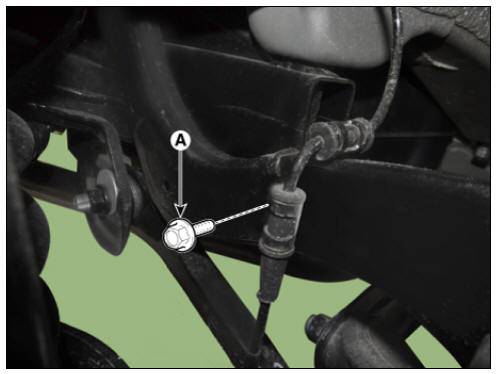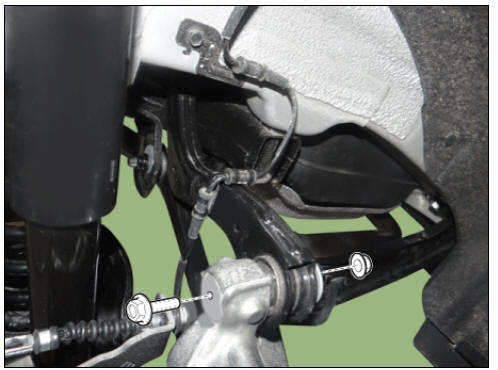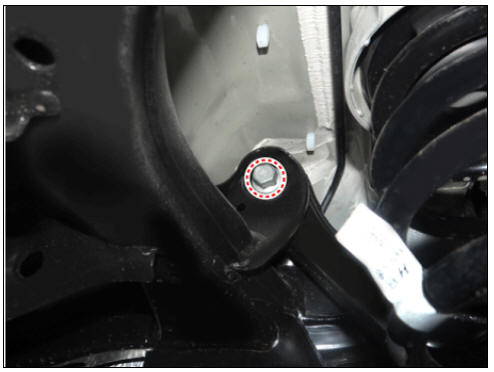KIA Niro: Rear Lower and Upper Arm Repair procedures
Removal
- Disconnect the battery negative cable.
- Remove the wheel and tire.
Tightening torque: 107.9 - 127.5 N*m (11.0 - 13.0 kgf*m, 79.6 - 94.0 lb*ft)

Warning
Be careful not to damage the wheel nuts when removing the wheel and tire.
- Loosen the rear lower arm bolt (A,B), rear shock absorber bolt (C) and stabilizer link bolt (D) and then remove the rear lower arm.
Tightening torque: (A) 107.9 - 117.7 N*m (11.0 - 12.0 kgf*m, 79.6 - 86.8 lb*ft) (B) 137.3 - 156.9 N*m (14.0 - 16.0 kgf*m, 101.3 - 115.7 lb*ft) (C) 98.0 - 117.6 N*m (10.0 - 12.0 kgf*m, 72.3 - 86.7 lb*ft) (D) 19.6 - 29.4 N*m (2.0 - 3.0 kgf*m, 14.5 - 21.7 lb*ft)

Warning
Set up the transmission jack under the lower arm in order to remove the shock absorber in no-load condition.
- Install in the reverse order of removal.
- Check the wheel alignment.
(Refer to Suspension System - "Alignment")
Inspection
- Check the bushing for wear and deterioration.
- Check the rear lower arm for deformation.
- Check the coil spring and spring pad for deterioration and deformation.
- Check all bolts and nut.
Rear Upper Arm Repair procedures
Removal
- Disconnect the battery negative cable.
- Remove the wheel and tire.
Tightening torque: 107.9 - 127.5 N*m (11.0 - 13.0 kgf*m, 79.6 - 94.0 lb*ft)

Warning
Be careful not to damage the wheel nuts when removing the wheel and tire.
- Loosen the wheel speed sensor bracket bolt (A) from the rear upper arm.
Tightening torque: 6.8 - 10.7 N*m (0.7 - 1.1 kgf*m, 5.0 - 7.9 lb*ft)

Warning
Set up the transmission jack under the lower arm in order to remove the shock absorber in no-load condition.
- Loosen the bolt from the upper arm.
Tightening torque: 137.3 - 156.9 N*m (14.0 - 16.0 kgf*m, 101.3 - 115.7 lb*ft)

- Loosen the upper arm bolt and then remove the upper arm.
Tightening torque: 137.3 - 156.9 N*m (14.0 - 16.0 kgf*m, 101.3 - 115.7 lb*ft)

- Install in the reverse order of removal.
Inspection
- Check the bushing for wear and deterioration.
- Check all bolts and nuts.
READ NEXT:
 Rear Stabilizer Bar Repair procedures
Rear Stabilizer Bar Repair procedures
Removal
Disconnect the battery negative cable.
Remove the wheel and tire.
Tightening torque:
107.9 - 127.5 N*m (11.0 - 13.0 kgf*m, 79.6 - 94.0 lb*ft)
Warning
Be careful not to damage the wheel nuts when removing the wheel and
tire.
 Trailing Arm Repair procedures
Trailing Arm Repair procedures
Removal
Disconnect the battery negative cable.
Remove the wheel and tire.
Tightening torque:
107.9 - 127.5 N*m (11.0 - 13.0 kgf*m, 79.6 - 94.0 lb*ft)
Warning
Be careful not to damage the wheel nuts when removing the wheel and
tire.
SEE MORE:
 Wheel alignment and tire
balance
Wheel alignment and tire
balance
The wheels on your vehicle were aligned
and balanced carefully at the factory to
give you the longest tire life and best
overall performance.
If you notice your vehicle vibrating when
driving on a smooth road, your wheels
may need to be rebal
 Air bag collision sensors
Air bag collision sensors
* The actual features in your vehicle may not necessarily be available due to
the
selected options or regions.
Supplemental Restraint System (SRS) control module/rollover sensor
Front impact sensor
Side pressure sensors (front door)
Categories
- Home
- KIA Niro EV, Hybrid - Second generation - (SG2) (2021-2024) - Owner's manual
- Kia Niro - First generation - (DE) (2017-2022) - Service and Repair Manual
- Contact Us
